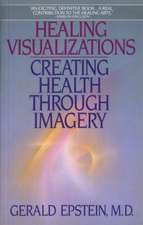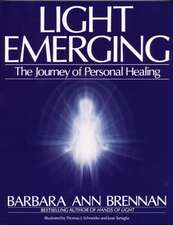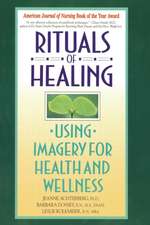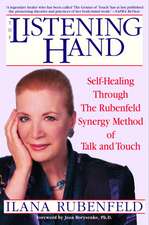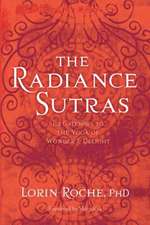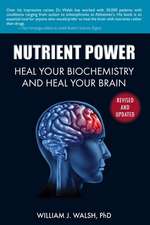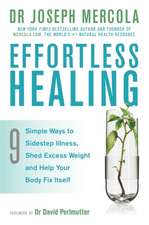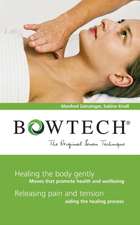Hands of Life: Use Your Body's Own Energy Medicine for Healing, Recovery, and Transformation
Autor Julie Motzen Limba Engleză Paperback – 31 ian 2000
As one of the first nontraditional healers allowed to work in an operating room, Julie Motz harnesses the body's own energy to help patients survive risky operations, such as heart transplants and cancer surgery. Now she shares remarkable case studies of healing, recovery, and transformation--and gives readers step-by-step guidance on accessing one's own innate healing energy.
Treating the body and spirit as an interconnected whole, Motz explains her breakthrough form of healing, the ultimate synthesis of Eastern holistic healing and Western medicine. She shows how strong emotion affects our bodies, creating energy imbalances that can lead to illness if unaddressed, and illustrates how we can heal.
Treating the body and spirit as an interconnected whole, Motz details her breakthrough form of healing, the ultimate synthesis of Eastern holistic healing and Western medicine. She explains how strong emotion affects our bodies, creating energy imbalances that can lead to illness if unaddressed, and illustrates how we can heal. -->
Preț: 115.78 lei
Nou
22.16€ • 23.08$ • 18.42£
Carte disponibilă
Livrare economică 18 ianuarie-01 februarie 25
Specificații
ISBN-10: 0553379259
Pagini: 320
Dimensiuni: 150 x 226 x 23 mm
Greutate: 0.48 kg
Editura: Bantam
Notă biografică
Extras
It has been eight months since I first walked through the doors of the department of cardiothoracic surgery of Columbia Presbyterian Medical Center in upper Manhattan. The department has its suite of elegant offices in one wing of the seventh floor of the center's newest building, and patients recovering from its highly technical and remunerative surgeries occupy another. It has been five months since I began treating some of these patients, using the energy that flows through my hands to help them heal the terrible and awesome things that have happened inside their chests. It has been a month since I first met George, the patient who will change my life.
For a while, just to be doing such healing work, and to have it be effective in the highly mechanized and computerized realm of academic medicine, where machines extend life beyond anybody's wildest dreams, was mystery and challenge enough. But for the past few weeks I have been in the grip of an obsession about the operating room. If I can be effective after surgery, what might I accomplish if I could run energy into these open and wounded bodies while the transformation under the surgeon's knife is actually occurring?
I don't bother to think about the fact that this has never been done before--the idea seems to me so natural, such an obvious extension of what I am already doing. I don't bother to think that what I'm doing already seems odd enough to the nurses and the attending cardiologists on the unit--and even to Dr. Mehmet Oz, the surgeon whose patients I am treating.
What I think about are scalpels and saws cutting through unresisting flesh and bone, and pieces of anatomy being removed and rearranged, and the surrender to this invasion that the patient must endure. And I think about the energy in the room--the collective passions of surgeon and patient, each needing this process to succeed, but for different reasons.
The more I think about it, the more I am convinced that I belong there.
* * *
Dr. Oz has a coronary bypass scheduled for that afternoon, and we go down the escalators to the operating-room suite together. He punches in the code that allows the door to the surgical inner sanctum to open.
He leads me to the racks where blue scrub suits, masks, shower caps, and shoe coverings are stacked, then disappears behind a door through which I can hear men's voices and then laughter, as if someone has just told a joke. I enter the one marked "Women's Dressing Room," with the paraphernalia of his profession he has handed me clutched against my chest.
* * *
I meet him again in the corridor between the two dressing rooms. He shows me how to pinch the top of my mask so it stays up on my nose, and I follow him through a series of passageways and a set of swinging doors into the cube of unnaturally bright and beeping space that is the operating room.
* * *
To my surprise, the surgery seems already well under way. I later learn that Dr. Oz often does not "open" for himself, unless it is one of the trickier cases, like a mechanical heart implant, or a transplant involving a patient already on a mechanical heart. The preliminary work--in this case, painting the body with betadine, a disinfectant the color of dried blood, draping the sterile blue cloths around the area of the incision, cutting into the chest and sawing open the sternum, and even opening the leg to remove the veins that will take over the work of the coronary arteries--has already been done by a surgical resident.
I expect to just take a quick look around, introduce myself, and then leave, but Dr. Oz motions me to go stand at the head of the patient, as he disappears through a set of swinging doors opposite the ones through which we have entered. Stepping in front of the anesthesiologist, I realize that I am expected to watch the surgery--something I hadn't quite counted on.
In two minutes Dr. Oz is back, his hands dripping. A contraption like a miniature miner's lamp, with high-powered binocular spectacles attached, is strapped to his head. He dives into the surgical gloves the nurse holds out for him, and slips into the sterile gown, which she ties behind him. He positions himself on the right side of the body, with his back to a machine that powers the lamp's high-intensity beam.
Virtually nothing of the patient is visible except the gaping wetness of her chest. I deduce that there is a woman under all the draping from the wisps of hair that I can just barely see protruding from the sides of her cap. I take a deep breath and look into the blood-filled space. I have never witnessed a surgery before, but I feel fortified by having seen a video that Dr. Oz lent me a few weeks before, of a mechanical heart implant procedure. I was able to watch the whole thing without turning my head away once. Very promising for someone who could never stand the sight of blood, I thought.
While Dr. Oz uses a tiny electric torch to cut closer to the heart, I notice the resident holding something in the air that looks like a worm but that I know must be a vein. And then it happens--I hear, with what set of ears I do not know, the vein screaming in terror. The brain, shut down and furious, begins muttering "nobody told me about this, nobody told me about this, nobody told me about this," like a mantra. The heart, without blood or pulse, is moaning in confusion and pain.
I look around me. I check out the surgical nurse, passing instruments to the surgeons; the circulating nurse, moving between the sterile and nonsterile fields; the perfusionists, monitoring the heart-lung machine; the attending and resident anesthesiologists, busy writing notes; Dr. Oz and the surgical resident, peering into and poking away at the chest cavity. Nobody seems to notice a thing. Everybody is proceeding briskly, if not exactly cheerfully, with his or her task, as if this emotional cacophony were not going on.
I wonder if I'm going crazy--and then I think about all the messages I have received from people's bodies over the years in which I have worked as an energy healer. I know that this ability to tune in and hear or feel what is going on inside them is one of the reasons people come to me for healing. But this is different. I have never heard a part of a body screaming, muttering, or moaning before.
What strikes me at the moment is how totally unprepared the body seems to be for what is happening to it. No one has warned the vein that it is going to be removed from its cozy, familiar position in the leg, with sluggish venous blood oozing comfortably through it, to take up duty as a coronary artery, sustaining the fast, throbbing flow of arterial blood. No one has told the brain that muscles will not respond to the frantic messages it sends firing down the nerves, or that it will have to nourish itself for an hour or more on chilled blood treated with a special chemical to keep it from clotting in the machine. No one has told the heart that it must lie quietly for a while, during which time its whole reason for being, the movement of blood through the body, will be taken over by an external device. And no one has thanked the body, either in parts or as a whole, for its courage in undergoing this ordeal.
Recenzii
--Bernie S. Siegel, M.D., author of Love, Medicine & Miracles
"Healing, after a considerable absence, is reentering modern medicine, and Julie Motz is among the brave new healers who are showing the way."
--Larry Dossey, M.D., author of Prayer is Good Medicine and Healing Words
"With warmth, humor and well-paced prose, she offers a fascinating look at her work, her patients, and the ways her techniques can be adapted for everyday self-discoveries."
--Publishers Weekly
A Main Selection of One Spirit Book Club
An Alternate Selection of Quality Paperback Book Club
"Healing, after a considerable absence, is reentering modern medicine, and Julie Motz is among the brave new healers who are showing the way." --Larry Dossey, M.D., author of Prayer Is Good Medicine and Healing Words
"With warmth, humor and well-paced prose, she offers a fascinating look at her work, her patients, and the ways her techniques can be adapted for everyday self-discoveries."--Publishers Weekly -->
Textul de pe ultima copertă
As one of the first nontraditional healers allowed to work in an operating room, Julie Motz harnesses the body's own energy to help patients survive risky operations, such as heart transplants and cancer surgery. Now she shares remarkable case studies of healing, recovery, and transformation -- and gives readers step-by-step guidance on accessing one's own innate healing energy.
Treating the body and spirit as an interconnected whole, Motz explains her breakthrough form of healing, the ultimate synthesis of Eastern holistic healing and Western medicine. She shows how strong emotion affects our bodies, creating energy imbalances that can lead to illness if unaddressed, and illustrates how we can heal.

